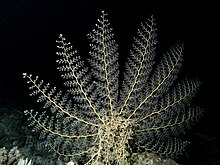| Gorgonocephalidae | |
|---|---|

| |
|
Scientific classification
| |
| Domain: | Eukaryota |
| Kingdom: | Animalia |
| Phylum: | Echinodermata |
| Class: | Ophiuroidea |
| Order: | Phrynophiurida |
| Suborder: | Euryalina |
| Family: |
Gorgonocephalidae Ljungman, 1867 |
| Genera | |
|
See text | |
Gorgonocephalidae is a family of basket stars. They have characteristic many-branched arms.

Gorgonocephalidae are the largest ophiuroids ( Gorgonocephalus eucnemis can measure up to 70 cm in arm length with a disk diameter of 14 cm). [1]
Systematics and phylogeny
The family is divided into the following genera: [2]
|
|
Fossil record of Gorgonocephalidae dates back to Miocene. [3]
References
- ^ Grzimek's Animal Life Encyclopedia, vol 1, Gale Cengage 2003
- ^ "WoRMS - World Register of Marine Species - Gorgonocephalidae Ljungman, 1867". marinespecies.org. Retrieved 26 August 2014.
- ^ Kroh, A. 2003. First record of gorgonocephalid ophiuroids (Echinodermata) from the Middle Miocene of the Central Paratethys. Cainozoic Research 2: 143-155
| Gorgonocephalidae | |
|---|---|

| |
|
Scientific classification
| |
| Domain: | Eukaryota |
| Kingdom: | Animalia |
| Phylum: | Echinodermata |
| Class: | Ophiuroidea |
| Order: | Phrynophiurida |
| Suborder: | Euryalina |
| Family: |
Gorgonocephalidae Ljungman, 1867 |
| Genera | |
|
See text | |
Gorgonocephalidae is a family of basket stars. They have characteristic many-branched arms.

Gorgonocephalidae are the largest ophiuroids ( Gorgonocephalus eucnemis can measure up to 70 cm in arm length with a disk diameter of 14 cm). [1]
Systematics and phylogeny
The family is divided into the following genera: [2]
|
|
Fossil record of Gorgonocephalidae dates back to Miocene. [3]
References
- ^ Grzimek's Animal Life Encyclopedia, vol 1, Gale Cengage 2003
- ^ "WoRMS - World Register of Marine Species - Gorgonocephalidae Ljungman, 1867". marinespecies.org. Retrieved 26 August 2014.
- ^ Kroh, A. 2003. First record of gorgonocephalid ophiuroids (Echinodermata) from the Middle Miocene of the Central Paratethys. Cainozoic Research 2: 143-155